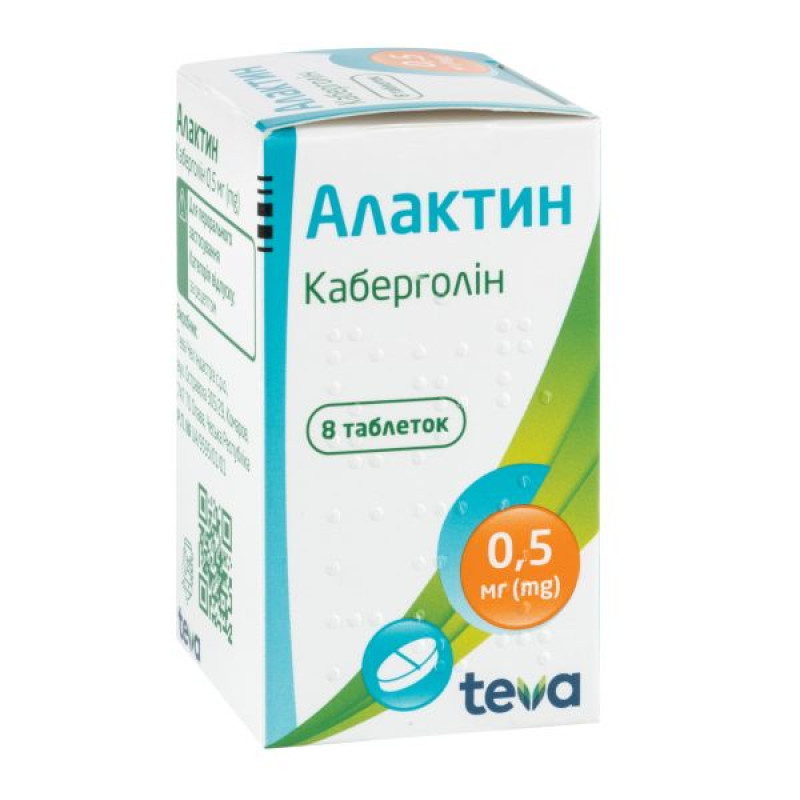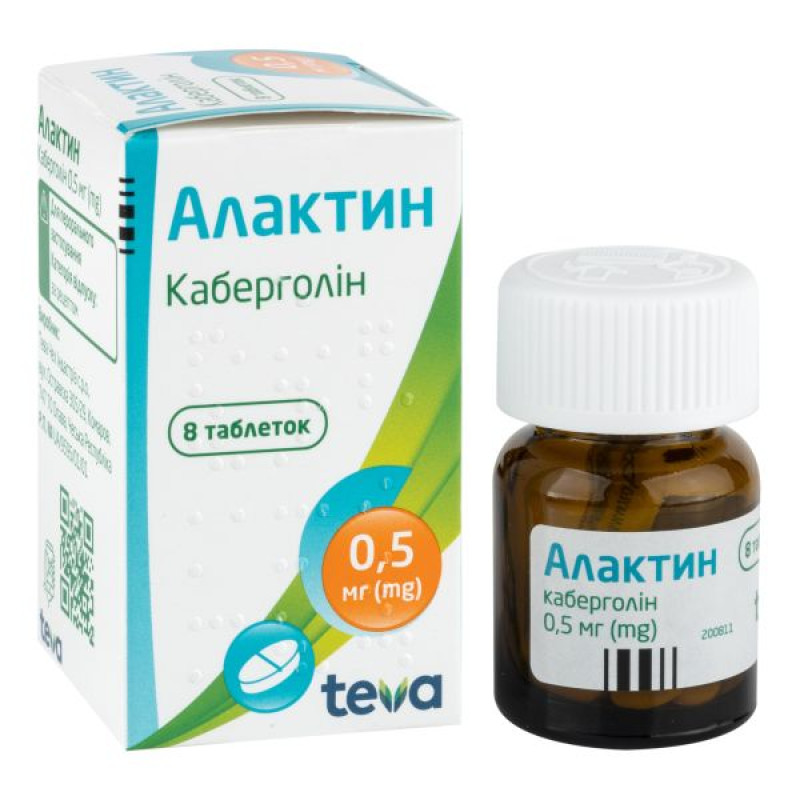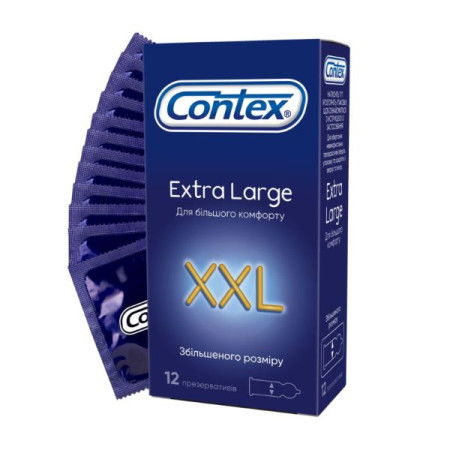Alactin tablets 0.5 mg No. 8

Instructions for Alactin tablets 0.5 mg No. 8
Composition
active ingredient: cabergoline;
1 tablet contains 0.5 mg of cabergoline;
excipients: anhydrous lactose, leucine, magnesium stearate.
Dosage form
Pills.
Main physicochemical properties: white, oval, flat, beveled tablets containing 0.5 mg of cabergoline. Each tablet has a score line on one side and is embossed with “CBG” on one side of the score line and “0.5” on the other side of the score line.
Pharmacotherapeutic group
Drugs used in gynecology. Prolactin inhibitors. ATX code G02C B03.
Pharmacological properties
Pharmacodynamics
Cabergoline is a synthetic ergot alkaloid and ergoline derivative that has a pronounced and long-lasting prolactin-lowering effect.
The prolactin-lowering effect is dose-dependent. A decrease in plasma prolactin levels is observed 3 hours after taking the drug and persists for 2-3 weeks. The long-acting effect means that a single dose is sufficient to stop the stimulation of milk secretion. In the treatment of hyperprolactinemia, serum prolactin levels normalize within 2-4 weeks after reaching the optimal dose. Prolactin levels may still decrease significantly for several months after discontinuation of treatment.
As for the endocrine effects of cabergoline, not related to the antiprolactinemic effect, the data obtained in animal experiments confirm that the drug under study has a very selective action without affecting the basal secretion of other pituitary hormones or cortisol.
The pharmacodynamic effect of cabergoline, which is not correlated with the therapeutic effect, concerns only the reduction of blood pressure. The maximum hypotensive effect of a single dose of cabergoline is usually achieved within the first 6 hours after taking the drug, and the maximum reduction in blood pressure and the frequency of this effect are dose-dependent.
Pharmacokinetics
Absorption: Cabergoline is rapidly absorbed from the gastrointestinal tract after oral administration, with peak plasma concentrations occurring within 0.5-4 hours.
Food intake does not affect the absorption and distribution of cabergoline.
Distribution: In vitro experiments have shown that cabergoline is 41-42% bound to plasma proteins at concentrations of 0.1-10 ng/ml.
Biotransformation. The main metabolite identified in urine is 6-allyl-8ß-carboxy-ergoline, which accounts for 4-6% of the dose. The other three metabolites account for less than 3% of the dose in total. The activity of the metabolites in inhibiting prolactin secretion, tested in vitro, is significantly lower than that of cabergoline.
Elimination: The elimination half-life of cabergoline is long: 79-115 hours in patients with hyperprolactinemia.
10 days after administration, approximately 18% and 72% of the dose were recovered in urine and feces, respectively. 2-3% of the dose was recovered in urine as unchanged drug.
Indication
Inhibition/suppression of physiological lactation
Alactin is prescribed to inhibit physiological postpartum lactation immediately after childbirth or to suppress established lactation in the following cases:
− after childbirth, if the mother has decided not to breastfeed the baby or when breastfeeding is contraindicated for the mother or the baby for medical reasons;
− after the birth of a stillbirth or abortion.
Treatment of hyperprolactinemic conditions
Alactin is indicated for the treatment of disorders associated with hyperprolactinemia, including amenorrhea, oligomenorrhea, anovulation and galactorrhea. The drug is indicated for the treatment of patients with prolactin-secreting pituitary adenomas (micro- and macroprolactinomas), idiopathic hyperprolactinemia or empty sella syndrome with concomitant hyperprolactinemia, which are the main pathological conditions causing the above-mentioned clinical manifestations.
Contraindication
Hypersensitivity to cabergoline, other ergot alkaloids or to any component of the drug.
History of fibrotic disease of the lungs, pericardium, and retroperitoneal space.
Liver failure and toxemia of pregnancy.
Concomitant use of antipsychotic medications.
For long-term treatment: signs of heart valve disease determined by echocardiography before treatment.
Postpartum hypertension or uncontrolled hypertension.
Preeclampsia, eclampsia.
History of psychosis or risk of developing postpartum psychosis.
Interaction with other medicinal products and other types of interactions
Despite the fact that there is no data on the interaction of Alactin with other ergot alkaloids, concomitant therapy with these drugs for a long time is not recommended.
Since Alactin exerts its effect by direct stimulation of dopamine receptors, simultaneous administration of dopamine antagonists (e.g. phenothiazines, butyrophenones, thioxanthenes, metoclopramide) is not recommended, so as not to reduce the clinical effect of the drug.
The drug should not be used with macrolide antibiotics (erythromycin) due to increased systemic bioavailability of cabergoline.
The interaction of Alactin with other drugs that lower blood pressure should be taken into account.
Application features
General.
Like other ergot alkaloids, Alactin should be used with caution in patients with severe cardiovascular disease, Raynaud's syndrome, gastric ulcer or gastrointestinal bleeding, and a history of serious mental illness.
There are no data on the effect of alcohol on the tolerability of cabergoline.
Symptomatic hypertension may develop with the use of cabergoline in any indication.
Liver failure.
In patients with severe hepatic impairment undergoing long-term treatment with cabergoline, it is advisable to consider using reduced doses of the drug. In contrast to healthy volunteers and individuals with less severe hepatic impairment, in patients with severe hepatic impairment (Child-Pugh class C) an increase in AUC was observed after a single dose of 1 mg.
Kidney failure.
No differences in the pharmacokinetics of cabergoline were observed in patients with moderate to severe renal disease. The pharmacokinetics of cabergoline in patients with end-stage renal disease or in patients undergoing hemodialysis have not been studied, so the drug should be used with caution in such patients.
Postural hypotension.
Postural hypotension has been observed during the use of Alactin. Therefore, it should be used with caution with drugs that can also lower blood pressure.
Fibrosis, cardiac valvulopathy and other critical phenomena.
Fibrous and serous inflammations such as pleurisy, pleural effusion, pleural fibrosis, pulmonary fibrosis, pericarditis, pericardial effusion, cardiac valvulopathy involving one or more valves (aortic, mitral and tricuspid), or retroperitoneal fibrosis occur after long-term use of ergoline derivatives with agonist activity at serotonin 5HT2B receptors, such as cabergoline. In some cases, the symptoms and clinical manifestations of cardiac valvulopathy are relieved after withdrawal of cabergoline.
The erythrocyte sedimentation rate (ESR) has been shown to be elevated above normal in pleural effusion/fibrosis. If the ESR is elevated above normal, a chest x-ray is recommended. Improvement in the patient's clinical condition has been reported after discontinuation of cabergoline when pleurisy/pulmonary fibrosis is diagnosed.
Valvulopathy has been observed with cumulative doses, therefore patients should be treated with the lowest effective dose. The benefit-risk balance for the patient should be reassessed at each visit to determine the appropriateness of continued treatment with cabergoline.
Before initiating long-term treatment, all patients should undergo cardiovascular evaluation, including echocardiography, to determine the presence of asymptomatic valvular disease. It is also advisable to determine baseline values, erythrocyte sedimentation rate or other markers of inflammation, pulmonary function (chest radiography), and renal function before starting treatment.
It is not known whether treatment with cabergoline may worsen the course of the disease in patients with valvular regurgitation. It has been established that patients with fibrotic valve changes should not receive treatment with cabergoline.
During long-term treatment: As fibrotic disorders may have an insidious onset, regular monitoring for possible signs of fibrosis progression should be carried out. Therefore, during treatment, attention should be paid to the following symptoms:
- pleuropulmonary disease, such as dyspnea, shortness of breath, persistent cough or chest pain;
- renal failure or obstruction of the ureter/abdominal vessels, which may manifest as back/flank pain and lower extremity swelling, as well as any abdominal masses or tenderness that may indicate retroperitoneal fibrosis;
- Heart failure: cases of valvular or pericardial fibrosis often present as heart failure. Therefore, valvular fibrosis (and constrictive pericarditis) should be ruled out when relevant symptoms occur.
Clinical diagnostic monitoring for the development of fibrotic disorders is mandatory. The first echocardiography should be performed within 3-6 months after the start of treatment; thereafter, the frequency of echocardiographic examinations should be determined by the relevant individual clinical signs, with particular attention to the symptoms listed above, but monitoring should be performed at least every 6-12 months.
Cabergoline should be discontinued if echocardiogram reveals new or worsening valvular regurgitation, valve restriction, or valve leaflet thickening.
The need for other clinical investigations (e.g., physical examination, cardiac auscultation, radiography, CT scan) should be determined on an individual basis.
Appropriate additional studies, such as erythrocyte sedimentation rate and serum creatinine, should be performed if necessary to confirm the diagnosis of fibrotic disorders.
Symptomatic hypotension may develop within 6 hours of administration of cabergoline, therefore, caution should be exercised when administering cabergoline concomitantly with other drugs that may lower blood pressure. Due to the half-life, the hypotensive effect may persist for several days after discontinuation of the drug. Monitoring with regular blood pressure checks is recommended during the first 3-4 days after initiation of therapy.
In studies of the postpartum period, cases of decreased blood pressure (≥ 20 mm Hg systolic and ≥ 10 mm Hg diastolic) were reported 3-4 days after a single dose of 1 mg cabergoline. Adverse effects were usually observed within the first two weeks, after which their manifestations decreased or disappeared completely.
Impulse control disorders.
Patients should be closely monitored for the development of impulse control disorders. Patients and their caregivers should be warned about possible changes in behavior that indicate impulse control disorders, such as pathological gambling, increased libido, hypersexuality, impulsive buying, binge eating, and compulsive eating, when using dopamine agonists, including cabergoline. In such cases, the dose of the drug should be reduced or the drug should be discontinued.
Inhibition/suppression of physiological lactation.
Like other ergot alkaloids, Alactin should be used in patients with pregnancy-induced hypertension only when the expected benefit of treatment outweighs the risk.
A single dose of 0.25 mg should be avoided in breastfeeding women to avoid the development of postural hypotension.
Treatment of hyperprolactinemia.
The underlying cause of hyperprolactinemia should be investigated before starting treatment with cabergoline, as hyperprolactinemia accompanied by amenorrhea/galactorrhea and infertility may be associated with pituitary tumors.
When an effective therapeutic dose is reached, monitoring of serum prolactin levels is recommended once a month; normalization of serum prolactin levels is usually observed within 2-4 weeks.
Recurrence of hyperprolactinemia is common after discontinuation of cabergoline. However, persistent suppression of prolactin levels has been observed for several months in some patients.
Before starting treatment for hyperprolactinemia, a diagnosis of the pituitary gland should be made. The drug restores ovulation and fertility in women with hyperprolactinemic hypogonadism, so it is recommended to perform a pregnancy test every 4 weeks during the period of amenorrhea and each time after the resumption of menstruation, if their delay is more than 3 days. Women who do not want to become pregnant should use mechanical contraception during therapy and after drug withdrawal until anovulation returns. If pregnancy occurs during treatment, cabergoline should be discontinued. As a precautionary measure, women who become pregnant should be monitored for signs of pituitary enlargement, since there is a possibility of an increase in the volume of an already existing pituitary tumor during pregnancy. Pregnancy should be excluded before prescribing the drug. Given the limited clinical experience with the drug and its long half-life, as a precautionary measure, women planning a pregnancy are advised to discontinue cabergoline use one month before the expected conception after achieving a regular ovulatory cycle. For patients taking the drug for a long time, regular gynecological examinations, including cytological examinations of the cervix and endometrium, are recommended.
Drowsiness/sudden falling asleep.
Cabergoline may cause drowsiness. Dopamine agonists may cause sudden sleep onset in patients with Parkinson's disease. Patients should be informed of the above information and advised to exercise caution when driving or operating machinery during treatment with cabergoline. Patients who experience drowsiness and/or episodes of sudden sleep onset should refrain from driving or operating machinery. In such patients, a dose reduction or discontinuation of treatment should be considered.
Other.
This medicinal product contains lactose. Patients with rare hereditary problems of galactose intolerance, the Lapp lactase deficiency or glucose-galactose malabsorption should not take this medicinal product.
Use during pregnancy or breastfeeding
Pregnancy.
Cases of major congenital malformations or premature termination of pregnancy have been reported after treatment with cabergoline in pregnant women. The most common neonatal anomalies were musculoskeletal and cardiopulmonary anomalies. There is no information on perinatal abnormalities or on the subsequent development of infants after intrauterine exposure to cabergoline. According to available publications, the prevalence of major congenital malformations in the general population is 6.9% or higher. The incidence of congenital anomalies varies in different populations. It is not possible to determine with certainty whether there is an increased risk.
Pregnancy should be ruled out before starting cabergoline and pregnancy should be avoided for at least one month after stopping treatment. Since the elimination half-life of cabergoline in patients with hyperprolactinemia is 79-115 hours, once a regular ovulatory cycle has been established, women who wish to become pregnant should stop taking cabergoline one month before the planned conception. This will prevent possible effects on the fetus and will not interfere with the possibility of conception, since in some cases the ovulatory cycle persists for six months after discontinuation of the drug. If conception occurs during treatment, treatment should be stopped after confirmation of pregnancy in order to limit the exposure of the fetus to the drug.
After stopping cabergoline, contraception should be used for at least 4 weeks.
Cabergoline restores ovulation and fertility in women with hyperprolactinemic hypogonadism: because pregnancy may occur before the menstrual cycle returns, it is recommended to perform a pregnancy test during the amenorrhea period, after menstruation has returned - whenever menstruation is delayed by more than three days. Women who do not wish to become pregnant are advised to use effective non-hormonal contraception during treatment and after stopping cabergoline.
Due to the long half-life and limited experience with the safety of cabergoline on the fetus, it is recommended that women planning a pregnancy wait at least one month after stopping cabergoline before conceiving. After pregnancy, women should be monitored for signs of pituitary enlargement, as pre-existing pituitary tumors may grow during pregnancy.
Breast-feeding.
Due to its ability to suppress lactation, cabergoline should not be used in women with hyperprolactinemic disorders who wish to breastfeed.
Cabergoline and/or its metabolites were excreted in milk in rats. There is no information on excretion in human milk; however, women should be advised not to breastfeed if lactation suppression with cabergoline is ineffective.
The ability to influence the reaction speed when driving or working with other mechanisms
During the first days of cabergoline use, patients should be cautioned against engaging in activities that require quick and accurate reactions.
Patients treated with cabergoline who experience somnolence and/or sudden sleep episodes are advised to refrain from driving or engaging in activities requiring alertness until such episodes and somnolence have resolved.
Method of administration and doses
Alactin is administered orally.
To reduce the risk of developing side effects from the digestive tract, it is recommended to take cabergoline with meals.
Inhibition/suppression of physiological lactation
For inhibition of postpartum lactation, Alactin should be used within the first 24 hours after delivery. The recommended therapeutic dose is 1 mg of cabergoline once.
For suppression of existing lactation – 0.25 mg every 12 hours for 2 days (total dose – 1 mg). This dosage regimen is better tolerated by women who decide to suppress lactation than taking it as a single dose, and it is accompanied by a lower incidence of adverse events, especially symptoms of arterial hypertension.
Treatment of hyperprolactinemic conditions
The recommended initial dose of Alactin is 0.5 mg once a week or ½ tablet of 0.5 mg twice a week (for example, on Monday and Thursday). If necessary, the dose can be gradually increased under the supervision of a doctor - by 0.5 mg per week at monthly intervals until a therapeutic effect is achieved. Usually, the therapeutic dose is 1 mg per week and can range from 0.25 mg to 2 mg per week.
The maximum dose of the drug should not exceed 3 mg/day.
The weekly dose of the drug may be administered once or divided into two or more doses per week, depending on tolerability.
Dividing the weekly dose into several doses is recommended when the weekly dose is more than 1 mg.
When selecting the dose, patients should be examined to determine the minimum effective therapeutic dose. Normalization of prolactin levels is usually observed within 2-4 weeks of treatment.
After discontinuation of cabergoline, recurrence of hyperprolactinemia is usually observed.
Elderly patients.
Experience with the use of cabergoline in elderly people with hyperprolactinemia is limited.
Dose reduction or discontinuation of treatment.
Dose reduction or discontinuation of treatment should be considered in patients with:
− drowsiness or sudden falling asleep;
− liver dysfunction.
Children
The safety and efficacy of the drug in patients under 16 years of age have not been studied.
Overdose
Accidental ingestion of very high doses of the drug may cause nausea, vomiting, stomach upset, hypotension, and impaired consciousness (psychosis, hallucinations). In such cases, immediate medical attention is required.
In the event of overdose, general measures should be taken to remove unabsorbed drug and, if necessary, to maintain blood pressure. In addition, dopamine antagonists (e.g. domperidone, metoclopramide) may be recommended.
Adverse reactions
Side effects are dose-dependent and may decrease with gradual dose reduction.
In patients with known intolerance to dopaminergic drugs, the likelihood of adverse events may be reduced by initiating treatment with cabergoline at a low dose, e.g. 0.25 mg once weekly, followed by gradual increases to a therapeutic dose. In the event of persistent or severe adverse events, a temporary reduction in dose followed by a more gradual increase, e.g. by 0.25 mg/week every two weeks, may improve tolerability.
From the vascular system: hypotension with prolonged use, postural hypotension, peripheral vasospasm, fainting, hot flashes.
Cardiac disorders: cardiac valvulopathy (including regurgitation) and related disorders (pericarditis and pericardial effusion), palpitations, angina pectoris.
Musculoskeletal system: leg cramps, muscle weakness.
Skin and subcutaneous tissue disorders: skin reactions including alopecia, rash, pruritus, allergic skin reactions.
Immune system disorders: hypersensitivity reactions.
Mental disorders: depression, aggression, hypersexuality, pathological gambling, increased libido, delusions, hallucinations, psychotic disorders.
Nervous system: dizziness, vertigo, headache, paresthesia, syncope, tremor, sudden sleep onset, transient hemianopsia, drowsiness.
On the part of the digestive tract: abdominal and epigastric pain, dyspepsia, nausea, gastritis, constipation, vomiting.
From the reproductive system: pain in the mammary glands.
On the part of the organs of vision: visual impairment.
Respiratory system: dyspnea, respiratory failure, respiratory failure, epistaxis, pleural effusion, fibrosis (including pulmonary fibrosis), pleural fibrosis, chest pain.
Hepatobiliary system: liver dysfunction.
General disorders: asthenia, fatigue, edema, peripheral edema.
Laboratory studies: a decrease in hemoglobin levels has been observed in women with amenorrhea during the first month after menstruation, an asymptomatic decrease in blood pressure (≥ 20 mm Hg - systolic and ≥ 10 mm Hg - diastolic) may be observed once during the first 3-4 days after delivery, an increase in blood creatine phosphokinase levels, and abnormal liver function tests.
Description of selected adverse reactions
Impulse control disorders: pathological gambling, increased libido, hypersexuality, impulsive buying, binge eating, impulsive eating when using dopamine agonists, including cabergoline.
The following adverse reactions were also observed: nervousness, dysmenorrhea, acne, pain, arthralgia, rhinitis, dry mouth, diarrhea, abdominal distension, throat irritation, toothache, cold-like symptoms, periorbital edema, peripheral edema, anorexia, insomnia, weight gain/loss, impaired concentration, agitation.
Expiration date
2 years.
Storage conditions
Store at a temperature not exceeding 30 ° C in the original packaging to protect from moisture and out of the reach of children. Do not remove the mini-packet with silica gel to adsorb moisture from the bottle.
Packaging
2 or 8 tablets per bottle; 1 bottle per box. The bottle contains a mini-packet of silica gel to absorb moisture.
Vacation category
According to the recipe.
Producer
Teva Czech Industries s.r.o.
Location of the manufacturer and address of the place of implementation of its activities
Ostravska Street 29, 74770 Opava-Komarov, Czech Republic.
There are no reviews for this product.
There are no reviews for this product, be the first to leave your review.
No questions about this product, be the first and ask your question.














